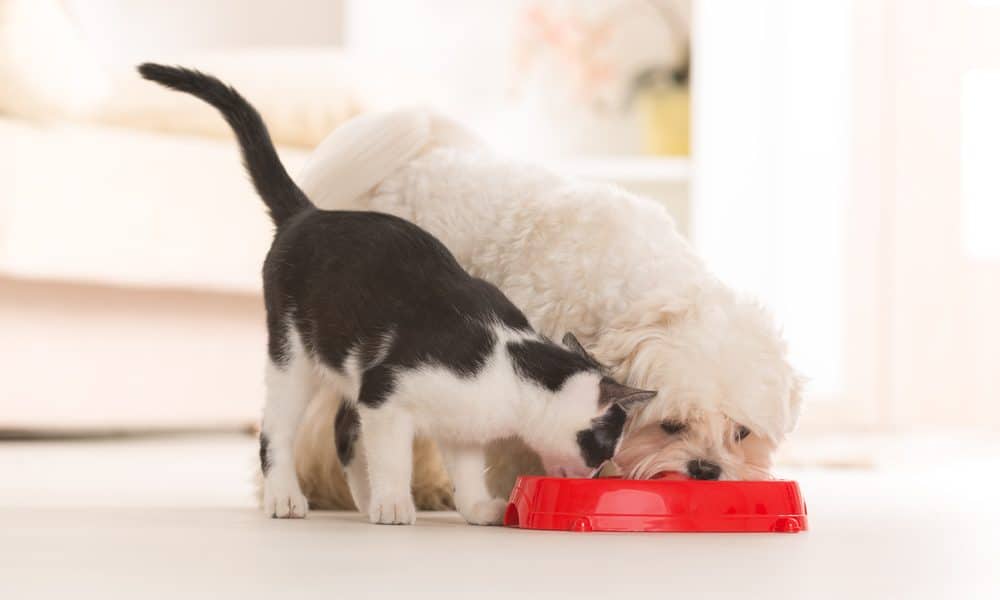Our pets rely on us to make the best food choices for them. But what is best? Wet food or dry food?
People decide which foods to feed their pets based on a number of different factors. It may be based on previous experience with pets, what the breeder has recommended or what their vet advises. And then there is the influence of hundreds of television, magazine and online advertisements, all of which claim to be the highest quality. So it’s little wonder so many of us get confused and doubtful about knowing what type of food is best.
Wet food: the good
- Wet food tends to be more palatable because it is made primarily of protein and fat.
- Because of the air-tight packaging, canned food normally contains no artificial preservatives and the meat ingredients tend to be closer to their natural state; making them not only appetising and palatable but beneficial as well.
- It is more easily digested, making the cleanup phase minimal.
- The palatability and digestibility of wet food make it the right choice for finicky eaters or pets with certain illnesses.
- Wet foods can be a good source of hydration if your animal is the type that is reluctant to drink adequate amounts of water.
- Wet foods are a good option for dogs with missing teeth, poorly aligned jaws, or smaller mouths.
- The moisture content of wet food can make the same amount of nutrients occupy more volume than that of dry food. This added moisture will help fill your dog’s belly, which will temporarily help your pup feel satiated without actually consuming more calories. So, if you have a dog of a New Year’s Diet, they can feel fuller — faster!
Wet food: the bad
- Once it has been opened, wet food loses any shelf life it had. It needs to be covered and refrigerated and used quickly
- Wet food is often more expensive than dry food
- Wet food won’t clean your dog’s teeth, which may lead to more plaque build-up and potentially tooth decay.
Dry food: the good
- Dry food is the most convenient type of food, for storage and for feeding.
- It has distinct benefits for your pets’s oral health. Chewing dry food helps to keep your pet’s teeth healthy by reducing plaque and tartar buildup. Since some dog breeds tend toward tooth and gum problems, dry food may help reduce these problems.
- This means pets that eat dry food tend to have better breath than those who chow down on canned food (that’s more for our benefit as nobody likes a stinky kiss!)
- There’s the added bonus of being able to fill a bowl with enough food to feed a pet for the entire day without it getting spoilt.
- Dry food can be used as an effective training treat
- Dry food is easy to measure out so food can be accurately and easily portioned to keep diets consistent.
Dry food: the bad
- Dry foods do not provide as much moisture as wet foods do, something that becomes more important as an animal ages, when an animal is ill, and in dry, hot climates.
- If your dog is very active, they may require higher fat than a dry dog food can provide as many dry foods have a reduced amount of fat content and an increased carbohydrate content.
- Also, as protein and fat content in dry foods rise, so do the prices which contradicts one of the major benefits of dry food: the relative inexpensiveness.
A mixed compromise?
Both dry and wet food should satisfy your pet’s nutritional requirements as long as they are well balanced and are made with quality ingredients. It’s just a matter of which one will be best for your pet over the long term. Since both wet and dry dog foods have their advantages, many pet owners find that mixing wet and dry together at feeding time provides the best of both worlds. Unless your dog has very specific dietary requirements, you might want to consider this option.
Your vet can help you determine the right combination of wet and dry foods to keep your dog healthy, and you can work out the what will keep their tummies happy, too. For the most part, consistency of dry foods will keep digestion steady, while the flavour of wet foods mixed in can change to keep your pup interested in mealtime.


